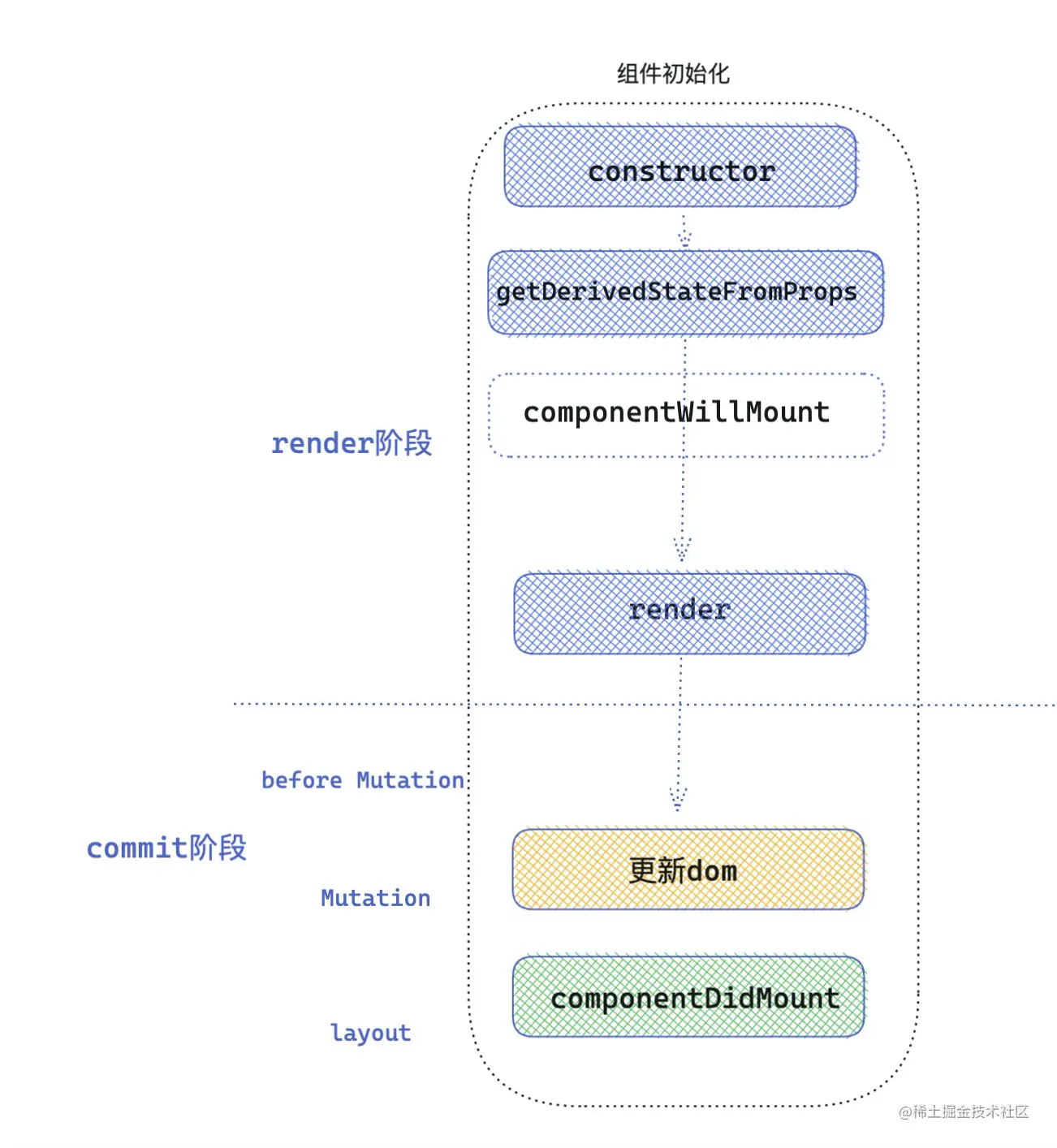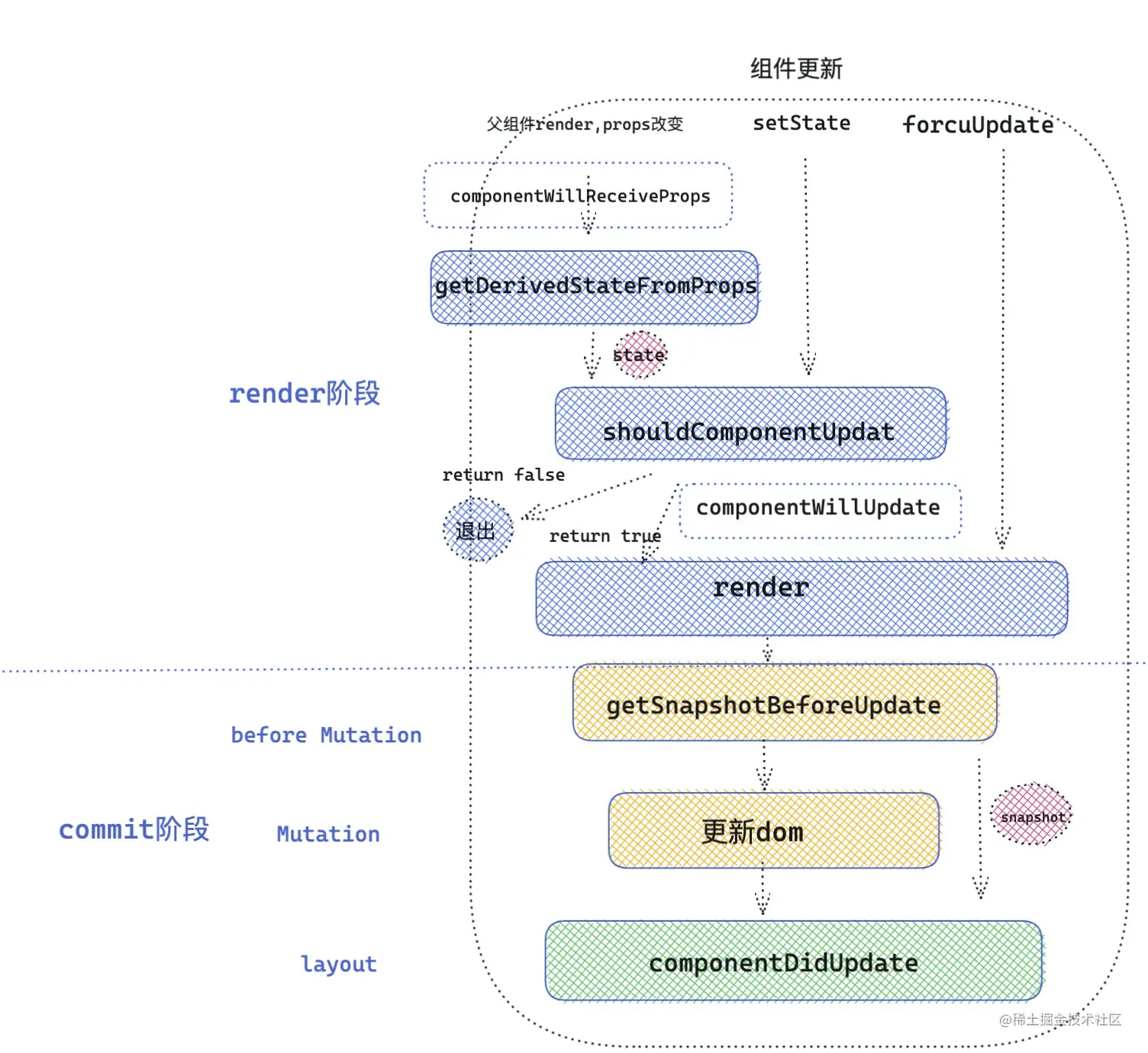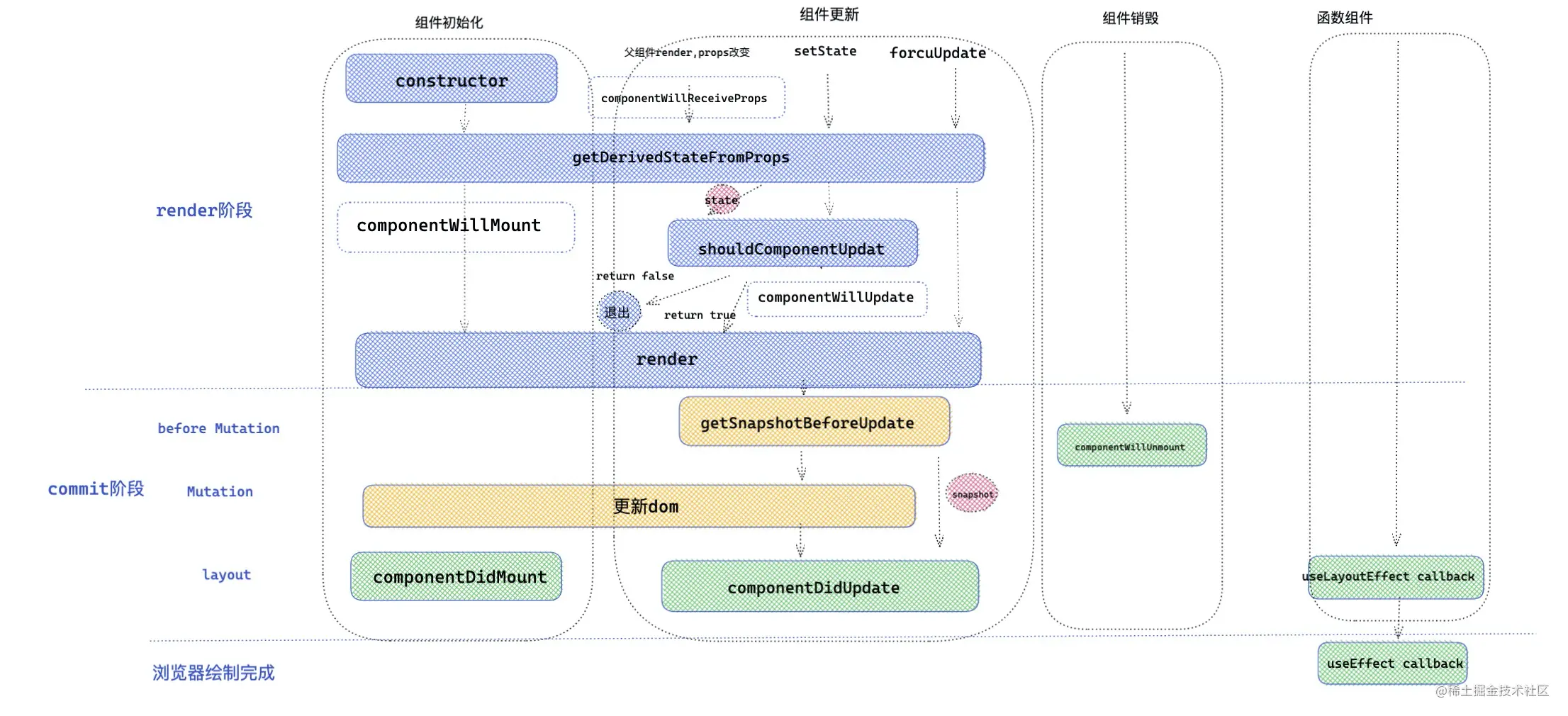React 生命周期
React 类组件为开发者提供了一些生命周期钩子函数,能让开发者在 React 执行的重要阶段,在钩子函数里做一些该做的事。自从 React Hooks 问世以来,函数组件也能优雅地使用 Hooks ,弥补函数组件没有生命周期的缺陷。
类组件生命周期
React 两个重要阶段,render 阶段和 commit 阶段,React 在调和( render )阶段会深度遍历 React fiber 树,目的就是发现不同( diff ),不同的地方就是接下来需要更新的地方,对于变化的组件,就会执行 render 函数。在一次调和过程完毕之后,就到了commit 阶段,commit 阶段会创建修改真实的 DOM 节点。
如果在一次调和的过程中,发现了一个 fiber tag = 1 类组件的情况,就会按照类组件的逻辑来处理。对于类组件的处理逻辑,首先判断类组件是否已经被创建过
// react-reconciler/src/ReactFiberBeginWork.js
/* workloop React 处理类组件的主要功能方法 */
function updateClassComponent(){
let shouldUpdate
const instance = workInProgress.stateNode // stateNode 是 fiber 指向 类组件实例的指针。
if (instance === null) { // instance 为组件实例,如果组件实例不存在,证明该类组件没有被挂载过,那么会走初始化流程
constructClassInstance(workInProgress, Component, nextProps); // 组件实例将在这个方法中被new。
mountClassInstance( workInProgress,Component, nextProps,renderExpirationTime ); //初始化挂载组件流程
shouldUpdate = true; // shouldUpdate 标识用来证明 组件是否需要更新。
}else{
shouldUpdate = updateClassInstance(current, workInProgress, Component, nextProps, renderExpirationTime) // 更新组件流程
}
if(shouldUpdate){
nextChildren = instance.render(); /* 执行render函数 ,得到子节点 */
reconcileChildren(current,workInProgress,nextChildren,renderExpirationTime) /* 继续调和子节点 */
}
}几个重要概念:
- instance 类组件对应实例。
- workInProgress 树,当前正在调和的 fiber 树 ,一次更新中,React 会自上而下深度遍历子代 fiber ,如果遍历到一个 fiber ,会把当前 fiber 指向 workInProgress。
- current 树,在初始化更新中,current = null ,在第一次 fiber 调和之后,会将 workInProgress 树赋值给 current 树。React 来用 workInProgress 和 current 来确保一次更新中,快速构建,并且状态不丢失。
- Component 就是项目中的 class 组件。
- nextProps 作为组件在一次更新中新的 props 。
- renderExpirationTime 作为下一次渲染的过期时间。
在组件实例上可以通过 _reactInternals 属性来访问组件对应的 fiber 对象。在 fiber 对象上,可以通过 stateNode 来访问当前 fiber 对应的组件实例。
React 类组件生命周期执行过程
React 的大部分生命周期的执行,都在 mountClassInstance 和updateClassInstance 这两个方法中执行,把流程简化成 mount (初始化渲染) 和 update (更新)两个方向。从组件初始化,组件更新 , 组件销毁 ,三大阶段分析。
初始化阶段
constructor 执行
在 mount 阶段,首先执行的 constructClassInstance 函数,用来实例化 React 组件,组件中 constructor 就是在这里执行的。在实例化组件之后,会调用 mountClassInstance 组件初始化。
function mountClassInstance(workInProgress,ctor,newProps,renderExpirationTime){
const instance = workInProgress.stateNode;
const getDerivedStateFromProps = ctor.getDerivedStateFromProps;
if (typeof getDerivedStateFromProps === 'function') { /* ctor 就是我们写的类组件,获取类组件的静态方法 */
const partialState = getDerivedStateFromProps(nextProps, prevState); /* 这个时候执行 getDerivedStateFromProps 生命周期 ,得到将合并的state */
const memoizedState = partialState === null || partialState === undefined ? prevState : Object.assign({}, prevState, partialState); // 合并state
workInProgress.memoizedState = memoizedState;
instance.state = workInProgress.memoizedState; /* 将state 赋值给我们实例上,instance.state 就是我们在组件中 this.state获取的state*/
}
if(typeof ctor.getDerivedStateFromProps !== 'function' && typeof instance.getSnapshotBeforeUpdate !== 'function' && typeof instance.componentWillMount === 'function' ){
instance.componentWillMount(); /* 当 getDerivedStateFromProps 和 getSnapshotBeforeUpdate 不存在的时候 ,执行 componentWillMount*/
}
}getDerivedStateFromProps 执行
在初始化阶段,getDerivedStateFromProps 是第二个执行的生命周期,值得注意的是它是从 ctor 类上直接绑定的静态方法,传入 props ,state 。 返回值将和之前的 state 合并,作为新的 state ,传递给组件实例使用。
componentWillMount 执行
如果存在 getDerivedStateFromProps 和 getSnapshotBeforeUpdate 就不会执行生命周期componentWillMount。
render 函数执行
到此为止 mountClassInstancec 函数完成,但是上面 updateClassComponent 函数, 在执行完 mountClassInstancec 后,执行了 render 渲染函数,形成了 children , 接下来 React 调用 reconcileChildren 方法深度调和 children 。
componentDidMount执行
细心的同学可能发现,生命周期 componentDidMount 还没有出现,那么 componentDidMount 是如何执行的呢?上文中简单介绍了 render 和 commit 两个阶段,上述提及的几生命周期都是在 render 阶段执行的。一旦 React 调和完所有的 fiber 节点,就会到 commit 阶段,在组件初始化 commit 阶段,会调用 componentDidMount 生命周期。
// react-reconciler/src/ReactFiberCommitWork.js
function commitLifeCycles(finishedRoot,current,finishedWork){
switch (finishedWork.tag){ /* fiber tag 在第一节讲了不同fiber类型 */
case ClassComponent: { /* 如果是 类组件 类型 */
const instance = finishedWork.stateNode /* 类实例 */
if(current === null){ /* 类组件第一次调和渲染 */
instance.componentDidMount()
}else{ /* 类组件更新 */
instance.componentDidUpdate(prevProps,prevState,instance.__reactInternalSnapshotBeforeUpdate);
}
}
}
}从上面可以直观看到 componentDidMount 执行时机 和 componentDidUpdate 执行时机是相同的 ,只不过一个是针对初始化,一个是针对组件再更新。到此初始化阶段,生命周期执行完毕。
执行顺序:constructor -> getDerivedStateFromProps / componentWillMount -> render -> componentDidMount

更新阶段
类组件的更新阶段,到底会执行那些生命周期函数呢,回到了最开始 updateClassComponent 函数了,当发现 current 不为 null 的情况时,说明该类组件被挂载过,那么直接按照更新逻辑来处理。
// react-reconciler/src/ReactFiberClassComponent.js
function updateClassInstance(current,workInProgress,ctor,newProps,renderExpirationTime){
const instance = workInProgress.stateNode; // 类组件实例
const hasNewLifecycles = typeof ctor.getDerivedStateFromProps === 'function' // 判断是否具有 getDerivedStateFromProps 生命周期
if(!hasNewLifecycles && typeof instance.componentWillReceiveProps === 'function' ){
if (oldProps !== newProps || oldContext !== nextContext) { // 浅比较 props 不相等
instance.componentWillReceiveProps(newProps, nextContext); // 执行生命周期 componentWillReceiveProps
}
}
let newState = (instance.state = oldState);
if (typeof getDerivedStateFromProps === 'function') {
ctor.getDerivedStateFromProps(nextProps,prevState) /* 执行生命周期getDerivedStateFromProps ,逻辑和mounted类似 ,合并state */
newState = workInProgress.memoizedState;
}
let shouldUpdate = true
if(typeof instance.shouldComponentUpdate === 'function' ){ /* 执行生命周期 shouldComponentUpdate 返回值决定是否执行render ,调和子节点 */
shouldUpdate = instance.shouldComponentUpdate(newProps,newState,nextContext,);
}
if(shouldUpdate){
if (typeof instance.componentWillUpdate === 'function') {
instance.componentWillUpdate(); /* 执行生命周期 componentWillUpdate */
}
}
return shouldUpdate
}执行生命周期 componentWillReceiveProps
首先判断 getDerivedStateFromProps 生命周期是否存在,如果不存在就执行componentWillReceiveProps生命周期。传入该生命周期两个参数,分别是 newProps 和 nextContext 。
执行生命周期 getDerivedStateFromProps
接下来执行生命周期getDerivedStateFromProps, 返回的值用于合并state,生成新的state。
执行生命周期 shouldComponentUpdate
接下来执行生命周期shouldComponentUpdate,传入新的 props ,新的 state ,和新的 context ,返回值决定是否继续执行 render 函数,调和子节点。这里应该注意一个问题,getDerivedStateFromProps 的返回值可以作为新的 state ,传递给 shouldComponentUpdate 。
执行生命周期 componentWillUpdate
接下来执行生命周期 componentWillUpdate。updateClassInstance 方法到此执行完毕了。
执行 render 函数
接下来会执行 render 函数,得到最新的 React element 元素。然后继续调和子节点。
执行 getSnapshotBeforeUpdate
function commitBeforeMutationLifeCycles(current,finishedWork){
switch (finishedWork.tag) {
case ClassComponent:{
const snapshot = instance.getSnapshotBeforeUpdate(prevProps,prevState) /* 执行生命周期 getSnapshotBeforeUpdate */
instance.__reactInternalSnapshotBeforeUpdate = snapshot; /* 返回值将作为 __reactInternalSnapshotBeforeUpdate 传递给 componentDidUpdate 生命周期 */
}
}
}getSnapshotBeforeUpdate 的执行也是在 commit 阶段,commit 阶段细分为 before Mutation( DOM 修改前),Mutation ( DOM 修改),Layout( DOM 修改后) 三个阶段,getSnapshotBeforeUpdate发生在 before Mutation 阶段,生命周期的返回值,将作为第三个参数 __reactInternalSnapshotBeforeUpdate 传递给 componentDidUpdate 。
执行 componentDidUpdate
接下来执行生命周期 componentDidUpdate ,此时 DOM 已经修改完成。可以操作修改之后的 DOM 。到此为止更新阶段的生命周期执行完毕。

更新阶段对应的生命周期的执行顺序:
componentWillReceiveProps( props 改变) / getDerivedStateFromProp -> shouldComponentUpdate -> componentWillUpdate -> render -> getSnapshotBeforeUpdate -> componentDidUpdate
销毁阶段
function callComponentWillUnmountWithTimer(){
instance.componentWillUnmount();
}执行生命周期 componentWillUnmount
销毁阶段就比较简单了,在一次调和更新中,如果发现元素被移除,就会打对应的 Deletion 标签 ,然后在 commit 阶段就会调用 componentWillUnmount 生命周期,接下来统一卸载组件以及 DOM 元素。
类组件生命周期总览

各阶段生命周期的功能
上面介绍了 React 各生命周期的执行时机和执行顺序。下面介绍一下各个 lifecycle 能做些什么?
constructor
React 在不同时期抛出不同的生命周期钩子,也就意味这这些生命周期钩子的使命。上面讲过 constructor 在类组件创建实例时调用,而且初始化的时候执行一次,所以可以在 constructor 做一些初始化的工作。
constructor(props){
super(props) // 执行 super ,别忘了传递props,才能在接下来的上下文中,获取到props。
this.state={ //① 可以用来初始化state,比如可以用来获取路由中的
name:'alien'
}
this.handleClick = this.handleClick.bind(this) /* ② 绑定 this */
this.handleInputChange = debounce(this.handleInputChange , 500) /* ③ 绑定防抖函数,防抖 500 毫秒 */
const _render = this.render
this.render = function(){
return _render.bind(this) /* ④ 劫持修改类组件上的一些生命周期 */
}
}
/* 点击事件 */
handleClick(){ /* ... */ }
/* 表单输入 */
handleInputChange(){ /* ... */ }constructor 作用:
- 初始化 state ,比如可以用来截取路由中的参数,赋值给 state 。
- 对类组件的事件做一些处理,比如绑定 this , 节流,防抖等。
- 对类组件进行一些必要生命周期的劫持,渲染劫持,这个功能更适合反向继承的 HOC ,在 HOC 环节,会详细讲解反向继承这种模式。React HOC
getDerivedStateFromProps
getDerivedStateFromProps(nextProps,prevState)两个参数:
- nextProps 父组件新传递的 props ;
- prevState 传入 getDerivedStateFromProps 待合并的 state 。
getDerivedStateFromProps 方法作为类的静态属性方法执行,内部是访问不到 this 的,它更趋向于纯函数,从源码中就能够体会到 React 对该生命周期定义为取缔 componentWillMount 和 componentWillReceiveProps 。
这个生命周期用于,在初始化和更新阶段,接受父组件的 props 数据, 可以对 props 进行格式化,过滤等操作,返回值将作为新的 state 合并到 state 中,供给视图渲染层消费。
从源码中可以看到,只要组件更新,就会执行 getDerivedStateFromProps,不管是 props 改变,还是 setState ,或是 forceUpdate 。
static getDerivedStateFromProps(newProps){
const { type } = newProps
switch(type){
case 'fruit' :
return { list:['苹果','香蕉','葡萄' ] } /* ① 接受 props 变化 , 返回值将作为新的 state ,用于 渲染 或 传递给s houldComponentUpdate */
case 'vegetables':
return { list:['菠菜','西红柿','土豆']}
}
}
render(){
return <div>{ this.state.list.map((item)=><li key={item} >{ item }</li>) }</div>
}getDerivedStateFromProps 作用:
- 代替 componentWillMount 和 componentWillReceiveProps
- 组件初始化或者更新时,将 props 映射到 state。
- 返回值与 state 合并完,可以作为 shouldComponentUpdate 第二个参数 newState ,可以判断是否渲染组件。(请不要把 getDerivedStateFromProps 和 shouldComponentUpdate 强行关联到一起,两者没有必然联系)
componentWillMount 和 UNSAFE_componentWillMount
在 React V16.3 componentWillMount ,componentWillReceiveProps , componentWillUpdate 三个生命周期加上了不安全的标识符 UNSAFE,变成了如下形式,在目前最新的版本 React V17.0.2 也没有废弃这三个生命周期。可能不久之后更高级的版本会被废除吧,首先先来看一下为什么要加 UNSAFE,首先根据源码,大家有没有发现一个问题,就是这三个生命周期,都是在 render 之前执行的,React 对于执行 render 函数有着像 shouldUpdate 等条件制约,但是对于执行在 render 之前生命周期没有限制,存在一定隐匿风险,如果 updateClassInstance 执行多次,React 开发者滥用这几个生命周期,可能导致生命周期内的上下文多次被执行。
- UNSAFE_componentWillMount
- UNSAFE_componentWillReceiveProps
- UNSAFE_componentWillUpdate
UNSAFE_componentWillMount 的作用还是做一些初始化操作,但是不建议在这个生命周期写,毕竟未来 React 可能完全取缔它。
omponentWillReceiveProps 和 UNSAFE_componentWillReceiveProps
UNSAFE_componentWillReceiveProps 函数的执行是在更新组件阶段,该生命周期执行驱动是因为父组件更新带来的 props 修改,但是只要父组件触发 render 函数,调用 React.createElement 方法,那么 props 就会被重新创建,生命周期 componentWillReceiveProps 就会执行了。这就解释了即使 props 没变,该生命周期也会执行。
componentWillReceiveProps 可以用来干什么
UNSAFE_componentWillReceiveProps(newProps){
const { type } = newProps
console.log('父组件render执行') /* ① 监听父组件执行render */
setTimeout(()=>{ /* ② 异步控制props改变,派生出来的 state 的修改 */
switch(type){
case 'fruit' :
this.setState({list:['苹果','香蕉','葡萄' ] })
break
case 'vegetables':
this.setState({list:['苹果','香蕉','葡萄' ] })
break
}
},0)
}componentWillReceiveProps可以用来监听父组件是否执行 render 。componentWillReceiveProps可以用来接受 props 改变,组件可以根据 props 改变,来决定是否更新 state ,因为可以访问到 this , 所以可以在异步成功回调(接口请求数据)改变 state 。这个是getDerivedStateFromProps不能实现的。
不建议用这种方式,props 改变,再触发 componentWillReceiveProps 异步请求数据渲染,这样首先在没做优化前提下会带来两次子组件的更新,第一次 props 改变,第二次 props 改变,异步改变state 。其次该生命周期的不安全性。再者需要在该生命周期内部,设置大量的条件判断语句,通过 this.props , nextProps 判断 props 到底改变与否。所以完全可以换一种思路,那就是状态提升,把数据层完全托管父组件,子组件没有副作用,只负责渲染父组件传递的 props 即可。
当 props 不变的前提下, PureComponent 组件能否阻止 componentWillReceiveProps 执行?
答案是否定的,componentWillReceiveProps 生命周期的执行,和纯组件没有关系,纯组件是在 componentWillReceiveProps 执行之后浅比较 props 是否发生变化。所以 PureComponent 下不会阻止该生命周期的执行。
componentWillUpdate 和 UNSAFE_componentWillUpdate
UNSAFE_componentWillUpdate 可以意味着在更新之前,此时的 DOM 还没有更新。在这里可以做一些获取 DOM 的操作。就比如说在一次更新中,保存 DOM 之前的信息(记录上一次位置)。但是 React 已经出了新的生命周期 getSnapshotBeforeUpdate 来代替 UNSAFE_componentWillUpdate。
UNSAFE_componentWillUpdate(){
const position = this.getPostion(this.node) /* 获取元素节点 node 位置 */
}作用:获取组件更新之前的状态。比如 DOM 元素位置等。
render
所谓 render 函数,就是 jsx 的各个元素被 React.createElement 创建成 React element 对象的形式。一次 render 的过程,就是创建 React.element 元素的过程。那么可以在 render 里面做一些,createElement创建元素 , cloneElement 克隆元素 ,React.children 遍历 children 的操作。
getSnapshotBeforeUpdate
getSnapshotBeforeUpdate(prevProps,preState){}- prevProps更新前的props
- prevState更新前的state
获取更新前 DOM 的状态。该生命周期是在 commit 阶段的before Mutation ( DOM 修改前),此时 DOM 还没有更新,但是在接下来的 Mutation 阶段会被替换成真实 DOM 。此时是获取 DOM 信息的最佳时期,getSnapshotBeforeUpdate 将返回一个值作为一个snapShot(快照),传递给 componentDidUpdate作为第三个参数。
getSnapshotBeforeUpdate 这个生命周期意义就是配合componentDidUpdate 一起使用,计算形成一个 snapShot 传递给 componentDidUpdate 。保存一次更新前的信息。
componentDidUpdate
componentDidUpdate(prevProps, prevState, snapshot){
const style = getComputedStyle(this.node)
const newPosition = { /* 获取元素最新位置信息 */
cx:style.cx,
cy:style.cy
}
}- prevProps 更新之前的 props ;
- prevState 更新之前的 state ;
- snapshot 为 getSnapshotBeforeUpdate 返回的快照,可以是更新前的 DOM 信息。
作用
- componentDidUpdate 生命周期执行,此时 DOM 已经更新,可以直接获取 DOM 最新状态。这个函数里面如果想要使用 setState ,一定要加以限制,否则会引起无限循环。
- 接受 getSnapshotBeforeUpdate 保存的快照信息。
componentDidMount
componentDidMount 生命周期执行时机和 componentDidUpdate 一样,一个是在初始化,一个是组件更新。此时 DOM 已经创建完,既然 DOM 已经创建挂载,就可以做一些基于 DOM 操作,DOM 事件监听器。
async componentDidMount(){
this.node.addEventListener('click',()=>{
/* 事件监听 */
})
const data = await this.getData() /* 数据请求 */
}作用:
- 可以做一些关于 DOM 操作,比如基于 DOM 的事件监听器。
- 对于初始化向服务器请求数据,渲染视图,这个生命周期也是蛮合适的。
shouldComponentUpdate
shouldComponentUpdate(newProps,newState,nextContext){}shouldComponentUpdate 三个参数,第一个参数新的 props ,第二个参数新的 state ,第三个参数新的 context 。
这个生命周期,一般用于性能优化,shouldComponentUpdate 返回值决定是否重新渲染的类组件。需要重点关注的是第二个参数 newState ,如果有 getDerivedStateFromProps 生命周期 ,它的返回值将合并到 newState ,供 shouldComponentUpdate 使用。
shouldComponentUpdate(newProps,newState){
if(newProps.a !== this.props.a ){ /* props中a属性发生变化 渲染组件 */
return true
}else if(newState.b !== this.props.b ){ /* state 中b属性发生变化 渲染组件 */
return true
}else{ /* 否则组件不渲染 */
return false
}
}componentWillUnmount
componentWillUnmount 是组件销毁阶段唯一执行的生命周期,主要做一些收尾工作,比如清除一些可能造成内存泄漏的定时器,延时器,或者是一些事件监听器。
componentWillUnmount(){
clearTimeout(this.timer) /* 清除延时器 */
this.node.removeEventListener('click',this.handerClick) /* 卸载事件监听器 */
}作用
清除延时器,定时器。 一些基于 DOM 的操作,比如事件监听器。
函数组件生命周期
React hooks也提供了 api ,用于弥补函数组件没有生命周期的缺陷。其原理主要是运用了 hooks 里面的 useEffect 和 useLayoutEffect。
useEffect
useEffect(()=>{
return destory
},dep)- useEffect 第一个参数 callback, 返回的 destory , destory 作为下一次callback执行之前调用,用于清除上一次 callback 产生的副作用。
- 第二个参数作为依赖项,是一个数组,可以有多个依赖项,依赖项改变,执行上一次callback 返回的 destory ,和执行新的 effect 第一个参数 callback 。
对于 useEffect 执行, React 处理逻辑是采用异步调用 ,对于每一个 effect 的 callback, React 会向 setTimeout回调函数一样,放入任务队列,等到主线程任务完成,DOM 更新,js 执行完成,视图绘制完毕,才执行。所以 effect 回调函数不会阻塞浏览器绘制视图。
useLayoutEffect
useLayoutEffect 和 useEffect 不同的地方是采用了同步执行,那么和useEffect有什么区别呢?
首先 useLayoutEffect 是在 DOM 更新之后,浏览器绘制之前,这样可以方便修改 DOM,获取 DOM 信息,这样浏览器只会绘制一次,如果修改 DOM 布局放在 useEffect ,那 useEffect 执行是在浏览器绘制视图之后,接下来又改 DOM ,就可能会导致浏览器再次回流和重绘。而且由于两次绘制,视图上可能会造成闪现突兀的效果。
useLayoutEffect callback 中代码执行会阻塞浏览器绘制。
useEffect 与 useLayoutEffect 区别
一句话概括如何选择 useEffect 和 useLayoutEffect :修改 DOM ,改变布局就用 useLayoutEffect ,其他情况就用 useEffect 。
React.useEffect 回调函数 和 componentDidMount / componentDidUpdate 执行时机有什么区别 ?
useEffect 对 React 执行栈来看是异步执行的,而 componentDidMount / componentDidUpdate 是同步执行的,useEffect代码不会阻塞浏览器绘制。在时机上 ,componentDidMount / componentDidUpdate 和 useLayoutEffect 更类似。
useInsertionEffect
useInsertionEffect 是在 React v18 新添加的 hooks ,它的用法和 useEffect 和 useLayoutEffect 一样。那么这个 hooks 用于什么呢?
在介绍 useInsertionEffect 用途之前,先看一下 useInsertionEffect 的执行时机。
React.useEffect(()=>{
console.log('useEffect 执行')
},[])
React.useLayoutEffect(()=>{
console.log('useLayoutEffect 执行')
},[])
React.useInsertionEffect(()=>{
console.log('useInsertionEffect 执行')
},[])
// useInsertionEffect 执行 useLayoutEffect 执行 useEffect 执行可以看到 useInsertionEffect 的执行时机要比 useLayoutEffect 提前,useLayoutEffect 执行的时候 DOM 已经更新了,但是在 useInsertionEffect 的执行的时候,DOM 还没有更新。
本质上 useInsertionEffect 主要是解决 CSS-in-JS 在渲染中注入样式的性能问题。这个 hooks 主要是应用于这个场景,在其他场景下 React 不期望用这个 hooks
css-in-js 问题
CSS-in-JS 的注入会引发哪些问题呢? 首先看部分 CSS-in-JS 的实现原理,拿 Styled-components 为例子,通过styled-components,你可以使用ES6的标签模板字符串语法(Tagged Templates)为需要 styled 的 Component 定义一系列CSS属性,当该组件的JS代码被解析执行的时候,styled-components 会动态生成一个 CSS 选择器,并把对应的 CSS 样式通过 style 标签的形式插入到 head 标签里面。动态生成的 CSS 选择器会有一小段哈希值来保证全局唯一性来避免样式发生冲突。这种模式下本质上是动态生成 style 标签。
在 useLayoutEffect 使用 CSS-in-JS 会造成哪里问题呢?
- 首先 useLayoutEffect 执行的时机 DOM 已经更新完成,布局也已经确定了,剩下的就是交给浏览器绘制就行了。
- 如果在 useLayoutEffect 动态生成 style 标签,那么会再次影响布局,导致浏览器再次重回和重排。
这个是时候 useInsertionEffect 的作用就出现了,useInsertionEffect 的执行在 DOM 更新前,所以此时使用 CSS-in-JS 避免了浏览器出现再次重回和重排的可能,解决了性能上的问题。
在 useInsertionEffect 使用 CSS-in-JS 流程
export default function Index(){
React.useInsertionEffect(()=>{
/* 动态创建 style 标签插入到 head 中 */
const style = document.createElement('style')
style.innerHTML = `
.css-in-js{
color: red;
font-size: 20px;
}
`
document.head.appendChild(style)
},[])
return <div className="css-in-js" > hello , useInsertionEffect </div>
}生命周期在函数组件中的替代方案
componentDidMount 替代方案
React.useEffect(()=>{
/* 请求数据 , 事件监听 , 操纵dom */
},[]) /* 切记 dep = [] */这里要记住 dep = [] ,这样当前 effect 没有任何依赖项,也就只有初始化执行一次。
componentWillUnmount 替代方案
React.useEffect(()=>{
/* 请求数据 , 事件监听 , 操纵dom , 增加定时器,延时器 */
return function componentWillUnmount(){
/* 解除事件监听器 ,清除定时器,延时器 */
}
},[])/* 切记 dep = [] */在 componentDidMount 的前提下,useEffect 第一个函数的返回函数,可以作为 componentWillUnmount 使用。
componentWillReceiveProps 代替方案
说 useEffect 代替 componentWillReceiveProps 着实有点牵强。
- 首先因为二者的执行阶段根本不同,一个是在render阶段,一个是在commit阶段。
- 其次 useEffect 会初始化执行一次,但是 componentWillReceiveProps 只有组件更新 props 变化的时候才会执行。
React.useEffect(()=>{
console.log('props变化:componentWillReceiveProps')
},[ props ])此时依赖项就是 props,props 变化,执行此时的 useEffect 钩子。
React.useEffect(()=>{
console.log('props中number变化:componentWillReceiveProps')
},[ props.number ]) /* 当前仅当 props中number变化,执行当前effect钩子 */useEffect 还可以针对 props 的某一个属性进行追踪。此时的依赖项为 props 的追踪属性。如上述代码,只有 props 中 number 变化,执行 effect 。
componentDidUpdate 替代方案
useEffect 和 componentDidUpdate 在执行时期虽然有点差别,useEffect 是异步执行,componentDidUpdate 是同步执行 ,但都是在 commit 阶段 。但是向上面所说 useEffect 会默认执行一次,而 componentDidUpdate 只有在组件更新完成后执行。
React.useEffect(()=>{
console.log('组件更新完成:componentDidUpdate ')
}) /* 没有 dep 依赖项 */没有第二个参数,那么每一次执行函数组件,都会执行该 effect。
实现一个 ScrollView 组件
主要用于长列表渲染,滑动底部请求渲染列表
class ScrollView extends React.Component{
/* -----自定义事件---- */
/* 控制滚动条滚动 */
handerScroll=(e)=>{
const { scroll } = this.props
scroll && scroll(e)
this.handerScrolltolower()
}
/* 判断滚动条是否到底部 */
handerScrolltolower(){
const { scrolltolower } = this.props
const { scrollHeight , scrollTop , offsetHeight } = this.node
if(scrollHeight === scrollTop + offsetHeight){ /* 到达容器底部位置 */
scrolltolower && scrolltolower()
}
}
node = null
/* ---——---生命周期------- */
constructor(props) {
super(props)
this.state={ /* 初始化 Data */
list:[]
}
this.handerScrolltolower = debounce(this.handerScrolltolower,200) /* 防抖处理 */
}
/* 接收props, 合并到state */
static getDerivedStateFromProps(newProps){
const { data } = newProps
return {
list : data.list || [] ,
}
}
/* 性能优化,只有列表数据变化,渲染列表 */
shouldComponentUpdate(newProps,newState){
return newState.list !== this.state.list
}
/* 获取更新前容器高度 */
getSnapshotBeforeUpdate(){
return this.node.scrollHeight
}
/* 获取更新后容器高度 */
componentDidUpdate(prevProps, prevState, snapshot){
console.log('scrollView容器高度变化:' , this.node.scrollHeight - snapshot )
}
/* 绑定事件监听器 - 监听scorll事件 */
componentDidMount() {
this.node.addEventListener('scroll',this.handerScroll)
}
/* 解绑事件监听器 */
componentWillUnmount(){
this.node.removeEventListener('scroll',this.handerScroll)
}
render() {
const { list } = this.state
const { component } = this.props
return <div className="list_box" ref={(node) => this.node = node } >
<div >
{
list.map((item) => (
React.createElement(component,{ item , key: item.id }) //渲染 Item 列表内容。
))
}
</div>
</div>
}
}scrollview组件各个生命周期功能:
- constructor: 做数据初始化,将滑动处理函数,做防抖处理。
- getDerivedStateFromProps: 将 props 中的 list ,合并到 state 。
- componentDidMount: 绑定监听 scroll 事件。
- shouldComponentUpdate:性能优化,只有 list 改变,渲染视图。
- render: 渲染视图,渲染 Item 。
- getSnapshotBeforeUpdate:保存组件更新前的 scrollview 容器高度。
- componentDidUpdate:根据渲染前后容器高度,计算一次高度变化量。
- componentWillUnmount:解除 scroll 事件监听器。
使用:
/* item 完全是单元项的渲染ui */
function Item({item}) {
return <div className="goods_item" >
<img src={item.giftImage} className="item_image" />
<div className="item_content" >
<div className="goods_name" >
{item.giftName}
</div>
<div className="hold_price" />
<div className="new_price" >
<div className="new_price" >
<div className="one view">
¥ {item.price}
</div>
</div>
</div>
<img className='go_share go_text' />
</div>
</div>
}
function () {
const [ data , setData ] = useState({ list:[],page:0,pageCount:1 }) /* 记录列表数据 */
/* 请求数据 */
const getData = async ()=>{
if(data.page === data.pageCount) return console.log('没有数据了~')
const res = await fetchData(data.page + 1)
if(res.code === 0) setData({
...res,
list:res.page === 1 ? res.list : data.list.concat(res.list)
})
}
/* 滚动到底部触发 */
const handerScrolltolower = () => {
console.log('scroll已经到底部')
getData()
}
/* 初始化请求数据 */
useEffect(()=>{
getData()
},[])
return <ScrollView
data={ data } /* */
component={ Item } /* Item 渲染的单元组件 */
scrolltolower={ handerScrolltolower }
scroll={()=>{}}
/>
}问题
Q1. useEffect/useLayoutEffect/useInsertionEffect 有什么区别?
一句话概括如何选择 useEffect 和 useLayoutEffect :修改 DOM ,改变布局就用 useLayoutEffect ,其他情况就用 useEffect 。
- useInsertionEffect: useInsertionEffect 的执行时机要比 useLayoutEffect 提前,useLayoutEffect 执行的时候 DOM 已经更新了,但是在 useInsertionEffect 的执行的时候,DOM 还没有更新。本质上 useInsertionEffect 主要是解决 CSS-in-JS 在渲染中注入样式的性能问题。这个 hooks 主要是应用于这个场景,在其他场景下 React 不期望用这个 hooks。useInsertionEffect 的执行在 DOM 更新前,所以此时使用 CSS-in-JS 避免了浏览器出现再次重回和重排的可能,解决了性能上的问题。
- useLayoutEffect: useLayoutEffect 是在 DOM 更新之后,浏览器绘制之前,这样可以方便修改 DOM,获取 DOM 信息,这样浏览器只会绘制一次,如果修改 DOM 布局放在 useEffect ,那 useEffect 执行是在浏览器绘制视图之后,接下来又改 DOM ,就可能会导致浏览器再次回流和重绘。而且由于两次绘制,视图上可能会造成闪现突兀的效果。useLayoutEffect callback 中代码执行会阻塞浏览器绘制。
- useEffect:对于 useEffect 执行, React 处理逻辑是采用异步调用 ,对于每一个 effect 的 callback, React 会向 setTimeout回调函数一样,放入任务队列,等到主线程任务完成,DOM 更新,js 执行完成,视图绘制完毕,才执行。所以 effect 回调函数不会阻塞浏览器绘制视图。
顺序:useInsertionEffect -> DOM 更新 -> useLayoutEffect -> render -> useEffect
Q2. React.useEffect 回调函数 和 componentDidMount / componentDidUpdate 执行时机有什么区别 ?
useEffect 对 React 执行栈来看是异步执行的,而 componentDidMount / componentDidUpdate 是同步执行的,useEffect代码不会阻塞浏览器绘制。在时机上 ,componentDidMount / componentDidUpdate 和 useLayoutEffect 更类似。
Q3. 类组件生命周期
